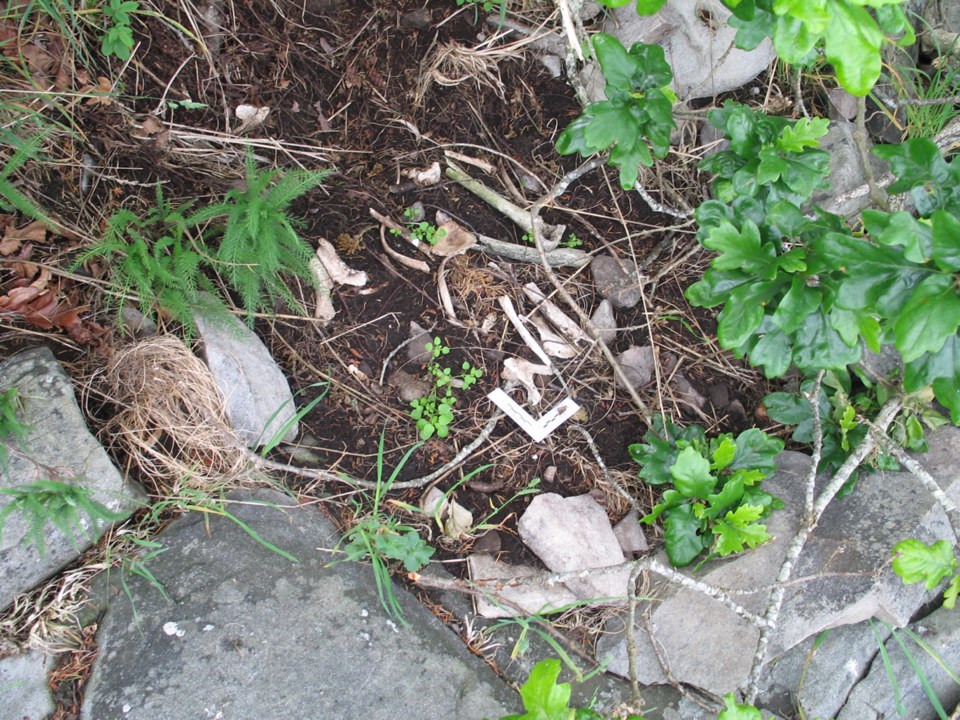Archeologists and First Nations are dismayed over recent comments by the owner of Grace Islet and the provincial government that downplay the controversial property as a documented burial ground.
“Either [the landowner] is grossly misinformed, or it is another cynical attempt to trivialize and devalue the scientific and First Nation cultural significance of ancient human remains and burial cairns at Grace Islet to help build his house,” said Eric McLay.
McLay, an archeologist, documented and photographed dozens of bones and burial cairns on the islet after kayakers discovered exposed human remains and turned them over to the Saltspring RCMP in 2006.
McLay was reacting to comments by Barry Slawsky, an Alberta businessman who bought the small residential-zoned island in Ganges Harbour in 1990. McLay and others say Grace Islet is part of a known First Nations village site and burial ground. A campaign to protect the islet, even expropriate it, has revved up since construction began this year.
In an Aug. 6 opinion piece in the Times Colonist, Slawsky said the islet is not a First Nations cemetery and that there were no confirmed burial cairns on the islet, only rock features that might have heritage importance.
His lawyers also sent a letter to the Capital Regional District after board members voted in July to lobby the provincial government to suspend construction on the islet, claiming a single femur fragment was the only instance of human remains found on the islet in 2007 and “no archaeological finding that any of the 15 rock features on Grace Islet are burial cairns.”
These claims came as a shock to archeologist Darcy Mathews, an expert in burial cairns and a specialist in Coast Salish culture, who was invited to Grace Islet by Stephen Acheson, project manager of the B.C. Archaeology Branch, in 2013.
“He asked me if I thought they were burial features, and I said I thought they were absolutely consistent with funerary cairns I’ve seen — which is about a thousand, many in this area,” said Mathews, noting he had only about 45 minutes on the islet.
He said he told Acheson the cairns might only represent a fraction of possible gravesites there.
“Burial cairns are only from one slice of time. There may have been below-ground burials but also above ground in the case of using canoes and burial houses,” he said. “An islet like this should absolutely be approached as a cemetery and properly looked at.”
Mathews said his recommendation to Acheson and the Archaeology Branch was to have a third-party specialist survey the islet prior to any building.
“To my knowledge, this didn’t happen,” he said. “I’m shocked the site permit was granted. They are proceeding without enough information to make these decisions. … If they can’t protect Grace Islet, what can they protect?”
Both McLay and Mathews expressed disappointment with the inconsistent stance of the Archaeology Branch on whether Grace Islet is a burial ground with burial cairns or not. The branch is responsible for the protection and preservation of human remains and artifacts under the Heritage Conservation Act.
Government briefing notes obtained through a freedom of information request state some of the rock cairns on Grace Islet were confirmed as burial cairns by a leading expert. However, more recently, Forests Ministry spokesman Greig Bethel said: “The only way to truly investigate these rock features/cairns is by taking them apart to determine if they contain remains.”
READ MORE: Download documents obtained through freedom of information request
To which Mathews responded: “That is wrong and not a valid argument. We have seen enough of these similar features to determine what they are.”
Documents also revealed the Archaeology Branch questioned the findings of the firm hired to assess the presence of remains on the islet — though it’s not clear how they were later addressed.
In a 2010 letter to the Bastion Group, permit officer Jim Stafford writes: “The report does not present any data in support of the conclusion that the rock features are unlikely to contain human remains. Instead, it includes several statements suggesting the rock features are likely to be burial cairns.”
Neither Slawsky nor an Archaeology Branch staff member responded to interview requests.
There is no question for Cowichan Tribes Chief William Seymour that Grace Islet is a cemetery and should be left alone.
“Because of our oral history, everything has been passed down from generation to generation. We know our ancestors travelled by canoe and laid to rest near the water,” said Seymour, who represents one of seven local bands working with others to suspend construction on the islet and negotiate with the owner.
“Denying there’s burials there, not acknowledging our claims, that’s new to us. I don’t know even what to say.”
He plans to attend a CRD meeting on Aug. 13, at which a motion will be introduced to begin the expropriation of Grace Islet.




